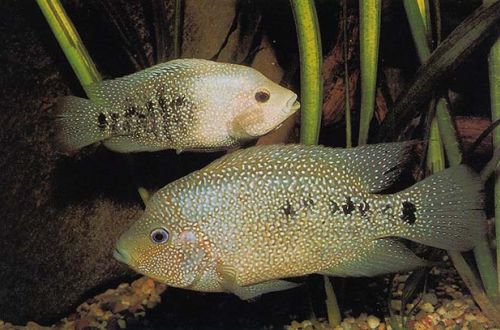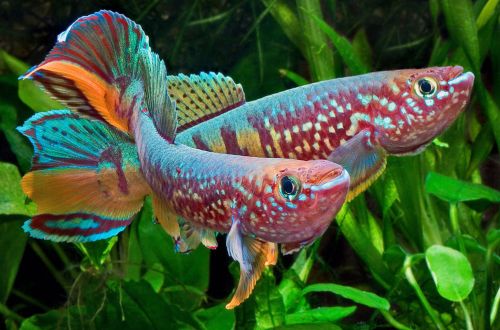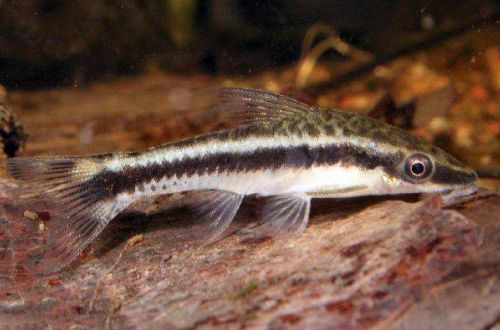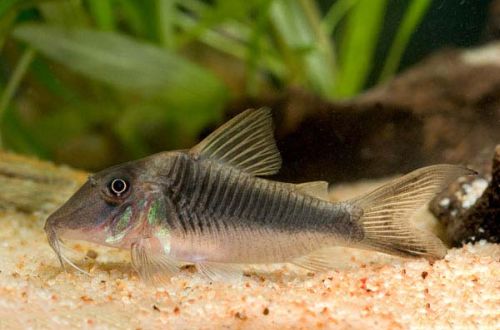
Cichlazoma diamond
The diamond cichlazoma, scientific name Herichthys cyanoguttatus, belongs to the Cichlidae family. Active temperamental fish with a complex behavior model, especially in terms of caring for offspring. Not recommended for beginner aquarists.

Contents
Habitat
The cichlid is native to North America. The natural habitat extends over the vast expanses of the Rio Grande Basin, which is the natural border between the United States and Mexico. Inhabits sections of rivers with a slow flow, swamps, lakes and ponds with dense aquatic vegetation and numerous flooded snags.
Brief information:
- The volume of the aquarium – from 300 liters.
- Temperature – 20-33°C
- Value pH — 6.0–7.5
- Water hardness – soft or medium hard (5-13 dGH)
- Substrate type – sandy or fine gravel
- Lighting – any
- Brackish water – no
- Water movement – light or moderate
- The size of the fish is up to 30 cm.
- Nutrition – any sinking food with herbal supplements
- Temperament – quarrelsome with bottom species
- Keeping alone or in a formed male/female pair
Description

Adult individuals reach a length of up to 30 cm. Males, unlike females, are noticeably larger, have pointed dorsal and anal fins. Dominant males often develop a hump (bump) on their heads, which is characteristic of many Central American cichlids.
The front part of the body is bluish or white, the tail part is dark. The pattern consists of numerous turquoise specks, unevenly scattered throughout the body and fins. Large dark spots may be visible along the lateral line.
Another closely related species has a similar color – Pearl cichlazoma (Herichthys carpintis). For a long time there has been confusion between the two species, due to which the same fish was erroneously supplied under different names.
Food
In nature, it feeds on almost everything that it can find at the bottom in the ground – small invertebrates, aquatic plants, detritus. In a home aquarium, the popular dry food in the form of flakes, granules can become the basis of the daily diet. It is recommended to choose foods rich in herbal ingredients. Many manufacturers produce specialized foods designed for specific groups of fish, including cichlazoma, which are a good choice for a beginner aquarist.
Maintenance and care, arrangement of the aquarium
The optimal size of the aquarium for one pair of fish starts from 300-350 liters. Although in nature they live among plants, but in a limited reservoir, the diamond cichlazoma begins to pose a danger to the plant landscape. The fish actively digs in the ground, uprooting plants, damaging the leaves. As an alternative, floating plants should be considered.
A feature of behavior involves a thick layer of soil of at least 8–10 cm from coarse sand, fine gravel and other similar substrates. In the design, it is desirable to provide places for shelters made of snags, heaps of stones or artificial decorative objects.
The fish prefer soft, slightly acidic water and are able to tolerate significant temperature rises (over 30°C). It is acceptable to be in an environment with low and medium hardness.
Aquarium maintenance is standard and includes a weekly replacement of part of the water (25% -40% of the volume) with fresh water, regular removal of organic waste and equipment maintenance.
Behavior and Compatibility
Territorial aggressive species. In small aquariums, males are intolerant of rivals. It is recommended to purchase fish at a young age by a heterosexual already formed pair. It is unacceptable to settle an adult male with an adult female, there is a high probability of aggression and death of a weak individual.
Compatible with large protected fish such as plecostomus and other catfish with strong “armor”.
Breeding / breeding
Receiving offspring is quite simple and quite achievable in a home aquarium. The fish become sexually mature at a size of about 6–9 cm in length. In the artificial environment of aquariums, they themselves determine the breeding season. The beginning of spawning is determined by the color, which during this period acquires more intense colors.
The courtship process can be lengthy and sometimes overly aggressive. In some cases, temporary relocation of the female to a separate tank is required.
The place for masonry is chosen with great care. Usually, it becomes some flat object at the bottom, for example, the surface of a boulder or a large stone.
The female lays several hundred eggs (up to 1000 pieces). The incubation period lasts 2-3 days, after which the appeared larvae are transferred to a pre-dug hole at the bottom, where they will stay for another 5-8 days. After about 1–2 weeks, the fry begin to swim freely in search of food. All this time, the parents actively protect their offspring, attacking anyone who may pose a potential threat.
Fish diseases
In a suitable habitat and balanced diet, cases of the disease rarely occur. If certain symptoms are detected or the onset of a disease is suspected, it is first necessary to check the quality and hydrochemical composition of the water. If deviations are found, bring the indicators back to normal and only then proceed with treatment. Sometimes it may not be required and the body of the fish itself will cope with the disease. Read more about symptoms and treatments in the Aquarium Fish Diseases section.





